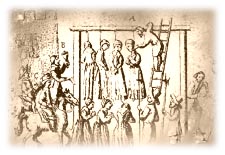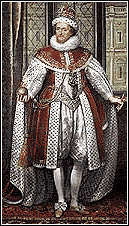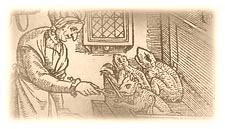Even if you believe in the so-called "evil power" of witches, the Scottish witch hunts of the late 16th and 17th centuries were among the most sadistic expression of state controlled violence in the country's history.
Compared to England, where the witchcraze was relatively low-key, an estimated 1300 suspected witches - almost all of them women - were executed in Scotland between 1590 and 1700: it is believed that hundreds more, perhaps thousands, died from torture, neglect and suicide while awaiting trial.
Yet in all of England, with a population twice that of Scotland, less than a thousand witches were executed during the same period.
There are many theories why the Scottish witch hunts were comparatively ferocious. Some say that the low execution rate of English witches was a sign of the improving position of women in English society. But Anne Llewellyn Barstow, author of Witchcraze: A New History of the European Witch Hunts (1994), and a leading authority on the subject, disputes that finding, saying that English society was certainly not lacking in misogyny (woman hatred).

Explanations for the relative restraint of England's witch hunt .... rest in its lack of Roman law and an inquisition, thereby permitting a prohibition on torture, and the absence of belief in the sabbat and the conspiracy theory of witchraft, not in an alleged privileged position of women.
Witchcraze
Barstow's study of the European witch hunts is considered a "must read" for scholars and has been widely applauded as one of the best treatments of the subject. In the case of Scotland, she cites Scottish expert, Christine Larner, as saying that the reason the witch hunts were so violent there was precisely because of the presence of beliefs that were - more or less - absent in England. Larner also blames the high execution rate in Scotland as influenced in a large part by the increasing patriarchy of a Calivinst society which was going through fundamental changes brought on by the Protestant Reformation.
Barstow writes:
Church and State appeared to have competed to see who could be the most Godly, that is, the most anti-Satan. Each time the royal courts would act to restrain the hunt, the General Assembly of the Presbyterian church (the state church) would order its ministers to seek out witches in every parish; when the church relaxed, the Privy Council would issue decrees for a new hunt. Between them they kept southern and eastern Scotland in an uproar over much of the period 1590 to 1700.
Witchcraze
 The Scottish witch hunts were aided and abetted by the extreme - and even paranoid - views of King James VI of Scotland. James fulfilled a lifelong objective - and became all powerful ruler of England, Scotland and Ireland - when he was crowned King of England in July, 1603, following the death of Elizabeth I. James was King of England for less than two weeks when the House of Lords passed a new and improved Witchcraft Act that had been the pride of Elizabeth's reign.
The Scottish witch hunts were aided and abetted by the extreme - and even paranoid - views of King James VI of Scotland. James fulfilled a lifelong objective - and became all powerful ruler of England, Scotland and Ireland - when he was crowned King of England in July, 1603, following the death of Elizabeth I. James was King of England for less than two weeks when the House of Lords passed a new and improved Witchcraft Act that had been the pride of Elizabeth's reign.
Prior to this, witches could only be executed for causing death. With James approval, witches could now be executed for a long list of offenses including causing hurt through evil spirits, finding stolen property through magic, causing unlawful love, or by merely intending to hurt someone.
 James so believed in the evil power of witches that he blamed a group of women at North Berwick for stirring up an ocean storm that delayed his bride's return by ship from Denmark. James took a personal interest in the North Berwick case, going so far as to interrogate the alledged witches himself.
James so believed in the evil power of witches that he blamed a group of women at North Berwick for stirring up an ocean storm that delayed his bride's return by ship from Denmark. James took a personal interest in the North Berwick case, going so far as to interrogate the alledged witches himself.
James even published a treatise, Daemonologie, in which he encouraged the use of torture and claimed that all witches must die by fire, even children. In Daemonologie, James introduced the notion of a demonic pact and the sabbat: he can thus be blamed for starting the witchcraze in Scotland.
It is estimated that nearly seven million people - mainly women - were persecuted, tortured and executed as witches during the European witchcraze of the 16th and 17th centuries.
MMJ, October, 1999
Links:
Witchcraze A New History of the European Witch Hunts
Bibliography of Scottish Witch Hunt Publiciations
The Witching Hours: Medieval Through Enlightenment Period European Witch History
Resources for Research on the History of the European Witch Hunts
Great Resources for Research on the History of the European Witch Hunts
King James VI of Scotland (aka James I of England)

